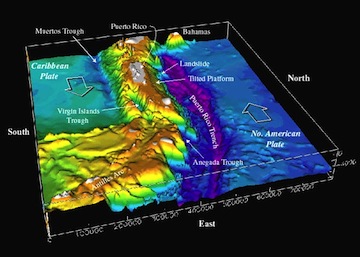You might expect the deepest spots in the oceans to be far away from land, but that isn’t the case. Most of them are within a couple of hundred miles of land — an island chain or the edge of a continent. In fact, they’re carved by the same process that creates land.
 These dark ocean depths are known as trenches. More than 20 of them have been discovered, with all but a few in the Pacific Ocean. They all reach depths of several miles, and the deepest of all — the Mariana Trench near Guam — bottoms out almost seven miles below the surface. The deepest one in the Atlantic Ocean, the Puerto Rico Trench, is only about five-and-a-half miles deep — the height of Mount Everest.
These dark ocean depths are known as trenches. More than 20 of them have been discovered, with all but a few in the Pacific Ocean. They all reach depths of several miles, and the deepest of all — the Mariana Trench near Guam — bottoms out almost seven miles below the surface. The deepest one in the Atlantic Ocean, the Puerto Rico Trench, is only about five-and-a-half miles deep — the height of Mount Everest.
A trench forms at the border between two of the “plates” that make up Earth’s crust. The plates are in constant motion as they float atop the molten rock below them, known as the mantle. In some cases, a plate made of denser rock plunges below a plate made of lighter rock. The edge of the denser plate bends a little, forming a deep V-shaped groove where it moves beneath the other. These grooves are the ocean trenches.
Trenches are difficult to explore. Even so, scientists have sent cameras and robotic submarines into some of them. And despite the pressure, the lack of sunlight, and the extreme cold, they’ve found life — sometimes lots of it. They’ve found sea cucumbers and a shrimp-like critter in the Mariana Trench, for example, and worms and sea anemones in another — hardy creatures living far below the surface of the sea.

